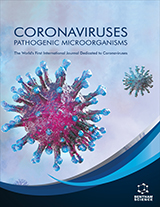Abstract
As of 1st of September 2020, the COVID-19 pandemic has reached an unprecedented level of more than 25 million cases with more than 850,000 deaths. Moreover, all the drug candidates are still undergoing testing in clinical trials. In this regard, a breakthrough in drug design is necessary. One strategy to devise lead compounds is leveraging natural products as a lead source. Several companies and research institutes are currently developing anti-SARS-CoV-2 lead from natural products. Flavonoids are well known as a class of antiviral compounds library. The objective of this research is to employ virtual screening methods for obtaining the best lead compounds from the library of flavonoid compounds. This research employed virtual screening methods that comprised of downloading the protein and lead compound structures, QSAR analysis prediction, iterations of molecular docking simulation, and ADME-TOX simulation for toxicity prediction. The QSAR analysis found that the tested compounds have broad-spectrum antiviral activity, and some of them exhibit specific binding to the 3C-like Protease of the Coronavirus. Moreover, juglanin was found as the compound with the fittest binding with the Protease enzyme of SARS-CoV-2. Although most of the tested compounds are deemed toxic by the ADME-Tox test, further research should be conducted to comprehend the most feasible strategy to deliver the drug to the infected lung cells. The juglanin compound is selected as the fittest candidate as the SARS-CoV-2 lead compound in the tested flavonoid samples. However, further research should be conducted to observe the lead delivery method to the cell.
Keywords: SARS-COV-2, SARS-COV-2 3CLpro, flavonoid, molecular docking, QSAR, ADME-Tox, COVID-19.
Graphical Abstract
Coronaviruses
Title:Virtual Screening of the Flavonoids Compounds with the SARS-CoV-2 3C-like Protease as the Lead Compounds for the COVID-19
Volume: 2 Issue: 11
Author(s): Gabriella Patricia Adisurja and Arli Aditya Parikesit*
Affiliation:
- Department of Bioinformatics, School of Life Sciences, Indonesia International Institute of Life Sciences (i3L), Jakarta,Indonesia
Keywords: SARS-COV-2, SARS-COV-2 3CLpro, flavonoid, molecular docking, QSAR, ADME-Tox, COVID-19.
Abstract: As of 1st of September 2020, the COVID-19 pandemic has reached an unprecedented level of more than 25 million cases with more than 850,000 deaths. Moreover, all the drug candidates are still undergoing testing in clinical trials. In this regard, a breakthrough in drug design is necessary. One strategy to devise lead compounds is leveraging natural products as a lead source. Several companies and research institutes are currently developing anti-SARS-CoV-2 lead from natural products. Flavonoids are well known as a class of antiviral compounds library. The objective of this research is to employ virtual screening methods for obtaining the best lead compounds from the library of flavonoid compounds. This research employed virtual screening methods that comprised of downloading the protein and lead compound structures, QSAR analysis prediction, iterations of molecular docking simulation, and ADME-TOX simulation for toxicity prediction. The QSAR analysis found that the tested compounds have broad-spectrum antiviral activity, and some of them exhibit specific binding to the 3C-like Protease of the Coronavirus. Moreover, juglanin was found as the compound with the fittest binding with the Protease enzyme of SARS-CoV-2. Although most of the tested compounds are deemed toxic by the ADME-Tox test, further research should be conducted to comprehend the most feasible strategy to deliver the drug to the infected lung cells. The juglanin compound is selected as the fittest candidate as the SARS-CoV-2 lead compound in the tested flavonoid samples. However, further research should be conducted to observe the lead delivery method to the cell.
Export Options
About this article
Cite this article as:
Adisurja Patricia Gabriella and Parikesit Aditya Arli *, Virtual Screening of the Flavonoids Compounds with the SARS-CoV-2 3C-like Protease as the Lead Compounds for the COVID-19, Coronaviruses 2021; 2 (11) : e130921191637 . https://dx.doi.org/10.2174/2666796702666210222105547
| DOI https://dx.doi.org/10.2174/2666796702666210222105547 |
Print ISSN 2666-7967 |
| Publisher Name Bentham Science Publisher |
Online ISSN 2666-7975 |
 368
368
- Author Guidelines
- Bentham Author Support Services (BASS)
- Graphical Abstracts
- Fabricating and Stating False Information
- Research Misconduct
- Post Publication Discussions and Corrections
- Publishing Ethics and Rectitude
- Increase Visibility of Your Article
- Archiving Policies
- Peer Review Workflow
- Order Your Article Before Print
- Promote Your Article
- Manuscript Transfer Facility
- Editorial Policies
- Allegations from Whistleblowers
- Announcements
Related Articles
-
Flu Viral Multiplex Testing and its Implication for COVID-19 Testing
New Emirates Medical Journal Antiviral Effects of Asian Natural Products Targeting SARS, MERS, and COVID-19
Coronaviruses Synthetic Lung Surfactant Treatment for COVID-19 Pneumonia
Coronaviruses Involvement of IL-1R/TLR Signalling in Experimental Autoimmune Encephalomyelitis and Multiple Sclerosis
Current Molecular Medicine Physical and Mental Functions of Cardiovascular Diseased Patients Decrease During the State of Emergency Initiated by the COVID-19 Pandemic in Japan
Reviews on Recent Clinical Trials An Overview on COVID-19 and its Effect on Cardiovascular Diseases
Endocrine, Metabolic & Immune Disorders - Drug Targets Knowledge Evaluation of Hand Hygiene and Infectious Diseases in Lebanon
Coronaviruses Clinical Review of COVID-19; Pathogenesis, Diagnosis, and Management
Current Pharmaceutical Design Economic Fluctuations: The Aftermath of COVID 19 Pandemic
Coronaviruses Melatonin Could Be Beneficial in SARS-CoV-2 Therapy
The Natural Products Journal Understanding the Role of HDL during COVID-19 Infection
Coronaviruses COVID-19, Angiotensin-Converting Enzyme 2 and Renin-Angiotensin System Inhibition: Implications for Practice
Current Hypertension Reviews The Therapeutic Potential of RNA Interference: Novel Approaches for Cancer Treatment
Current Pharmaceutical Biotechnology 2019 Novel Coronavirus: A Review on Epidemiology, Pathophysiology, Diagnosis and Current Clinical Trials in Vaccine Development
Coronaviruses Novel Coronavirus Disease 2019 (COVID-19) Current Update: Perspective on Epidemiology, Diagnosis, Drug Targets and Vaccines
Coronaviruses Inhibition of Membrane Fusion as a Target for Antiviral Therapy
Anti-Infective Agents in Medicinal Chemistry How India Fights with COVID-19 Learning from Highly Affected Countries
Current Signal Transduction Therapy Chitosan: A Promising Protective Component Against SARS-CoV-2 and Influenza Virus
Letters in Drug Design & Discovery Design, Synthesis and Antimicrobial Activity of α-Aminophosphonates of Quinoline and their Molecular Docking Studies Against DNA Gyrase A
Letters in Drug Design & Discovery The Challenges of Biomedical Waste Management During the Ongoing Coronavirus Disease-19 (COVID-19) Pandemic: The Current Scenario
Micro and Nanosystems



























